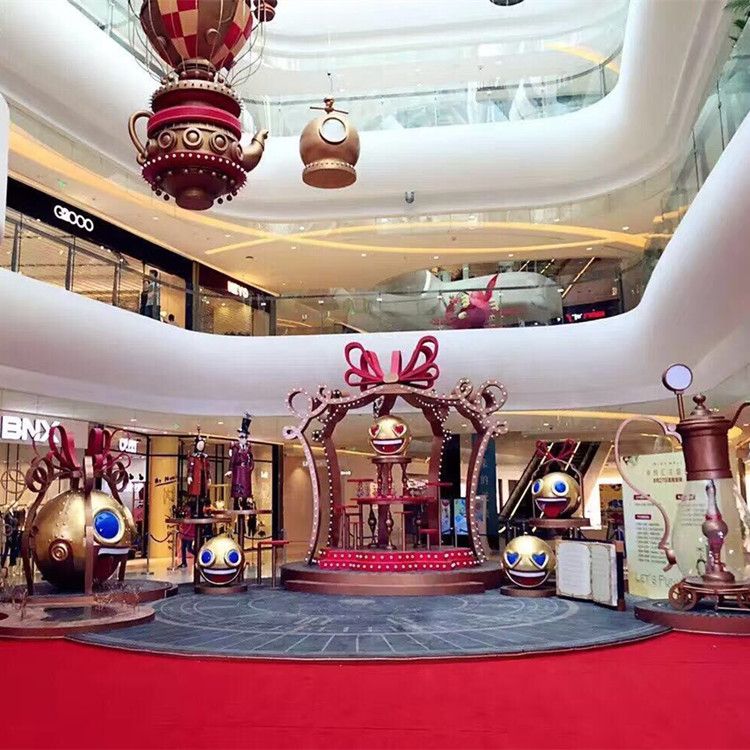Why is Commercial Installation Art Becoming a Trend in Modern Business Spaces?
2024-12-26
In recent years, the intersection of art and commerce has gained significant attention, with businesses across various industries incorporating commercial installation art into their spaces. But why is commercial installation art becoming such a prominent trend in modern business environments? Let’s delve into the reasons behind this growing movement and explore how art installations are reshaping the way companies engage with their customers, employees, and the world around them.
1. What Is Commercial Installation Art?
Commercial installation art refers to large-scale art pieces or immersive artistic experiences designed specifically for commercial spaces such as offices, retail stores, hotels, restaurants, or public spaces. These installations can include sculptures, interactive displays, murals, digital projections, and other creative elements that transform a space, offering a unique aesthetic and experience.
Unlike traditional artwork hung on a wall, commercial installation art is often designed to engage the senses and create an environment that resonates with the viewer. The goal is not only to beautify the space but also to foster emotional connections, spark curiosity, and leave a lasting impression.
2. How Does Commercial Installation Art Benefit Businesses?
The decision to invest in commercial installation art goes beyond simply beautifying a space. Companies are discovering that art installations offer a range of practical and emotional benefits:
- Creating Memorable Experiences: In a world where consumer attention spans are short, making a lasting impression is crucial. Commercial installations offer businesses the opportunity to create unique, unforgettable experiences that resonate with customers. Whether it’s a striking mural in a retail store or an interactive piece in a hotel lobby, art can spark conversation and leave customers with a positive, lasting memory of their visit.
- Enhancing Brand Identity: Commercial art installations can serve as a powerful tool for reinforcing a company’s brand identity. By aligning the artwork with the company’s values, mission, or aesthetic, businesses can create a cohesive and visually impactful brand presence. A carefully designed art installation can subtly convey messages about the business’s ethos and personality, connecting with customers on a deeper level.
- Attracting Foot Traffic: In retail, the use of installation art can be a powerful draw for customers. A well-executed installation can act as a magnet for foot traffic, encouraging people to visit a space simply to experience the art. As social media culture continues to influence consumer behavior, unique art installations often become shareable experiences, encouraging visitors to capture and share photos online. This organic exposure can help increase the business's visibility and attract more customers.
- Fostering Employee Engagement: In workplaces, commercial installation art has the power to enhance the work environment. Large-scale art pieces or creative installations can improve the atmosphere by adding vibrancy, warmth, and creativity to office spaces. Studies have shown that art in the workplace can boost employee morale, stimulate creativity, and increase overall well-being. Creating an inspiring environment can lead to higher productivity and a more engaged workforce.
- Boosting Customer Satisfaction: The aesthetic appeal of a well-curated art installation can make customers feel more comfortable and welcome. In hospitality or retail settings, art that resonates with the visitors can enhance the overall experience, creating an environment where customers feel more connected and emotionally engaged. This sense of satisfaction can translate into repeat business and positive word-of-mouth recommendations.
3. How Can Commercial Installation Art Be Integrated into Business Spaces?
There are various ways businesses can integrate commercial installation art into their spaces. The form and style of the art will depend on the nature of the business and the atmosphere it wishes to create. Here are a few examples of how art installations can be used effectively:
- Retail Stores: For retail spaces, installations can serve as eye-catching centerpieces or backdrop displays. Dynamic, interactive installations that invite customers to engage directly with the art can draw attention and create a unique shopping experience. Brands like Apple and Nike have mastered this approach, using minimalist yet powerful installations to emphasize their brand identity.
- Offices and Corporate Environments: In corporate settings, installations can enhance both the aesthetic appeal and the functionality of the workspace. Art pieces can be placed in lobbies, meeting rooms, or common areas to create a more inspiring environment. Some businesses may choose to feature artwork that reflects their corporate values or highlights their creative spirit, while others may invest in custom pieces that showcase their industry’s culture.
- Hotels and Restaurants: For hospitality businesses, commercial installation art plays a key role in setting the mood and atmosphere. Lobbies, dining areas, and hallways can be transformed with art that reflects the brand’s theme or local culture. Interactive or experiential installations can engage guests and provide them with a unique experience, enhancing the overall sense of hospitality.
- Public Spaces: Art installations in public spaces, such as parks, plazas, and transportation hubs, can attract visitors and create a sense of place. These installations may serve a functional purpose, such as providing seating or shade, while also enhancing the visual and cultural appeal of the area. Public art installations also have the ability to communicate messages of social importance or community engagement.
4. What Are the Different Types of Commercial Installation Art?
Commercial installation art can take on many forms, each with its own unique approach to creating an immersive environment. Some of the most popular types of commercial installation art include:
- Sculpture and 3D Installations: These large-scale pieces can be made from various materials, including metal, wood, plastic, or recycled materials. They are often designed to create a striking visual impact and are commonly found in outdoor spaces, lobbies, or public areas.
- Interactive Art Installations: These installations encourage direct engagement with the audience, allowing people to touch, move, or participate in the art. Interactive installations can be highly engaging, drawing people into the experience and fostering a deeper connection with the artwork.
- Digital Installations: With the rise of technology, many businesses are incorporating digital installations such as projection mapping, LED displays, and virtual reality into their spaces. These installations can be used to create dynamic and changing experiences that captivate visitors in unique ways.
- Mural and Wall Art: Painted murals or wall art can transform the ambiance of any space. This type of installation can be custom-designed to fit the theme or purpose of a business, providing a unique visual appeal that complements the overall design of the space.
5. What Are the Future Trends in Commercial Installation Art?
The future of commercial installation art is full of possibilities. As technology continues to advance, we can expect to see even more innovative and immersive installations, including:
- Augmented Reality (AR) and Virtual Reality (VR) Art: As AR and VR technologies evolve, more businesses may incorporate these interactive experiences into their spaces. These immersive environments allow customers to experience art in entirely new ways, creating a digital layer that enhances the physical space.
- Sustainable and Eco-friendly Installations: With a growing emphasis on sustainability, businesses may opt for art installations made from eco-friendly materials or pieces that communicate environmental awareness. Art that incorporates sustainable practices could become a key part of a business’s commitment to environmental responsibility.
- Artificial Intelligence and Algorithmic Art: AI-generated art could become a significant part of the commercial installation scene, allowing businesses to feature dynamic, ever-changing pieces that respond to customer behavior or environmental factors in real time.
Conclusion
Commercial installation art is not just a passing trend; it’s a powerful tool for businesses seeking to engage customers, enhance their brand identity, and create memorable experiences. As businesses continue to explore new ways of standing out in a competitive market, art installations offer a unique and effective way to do so. Whether in a retail space, office environment, or public area, these artistic expressions add depth, creativity, and meaning to any commercial setting.



